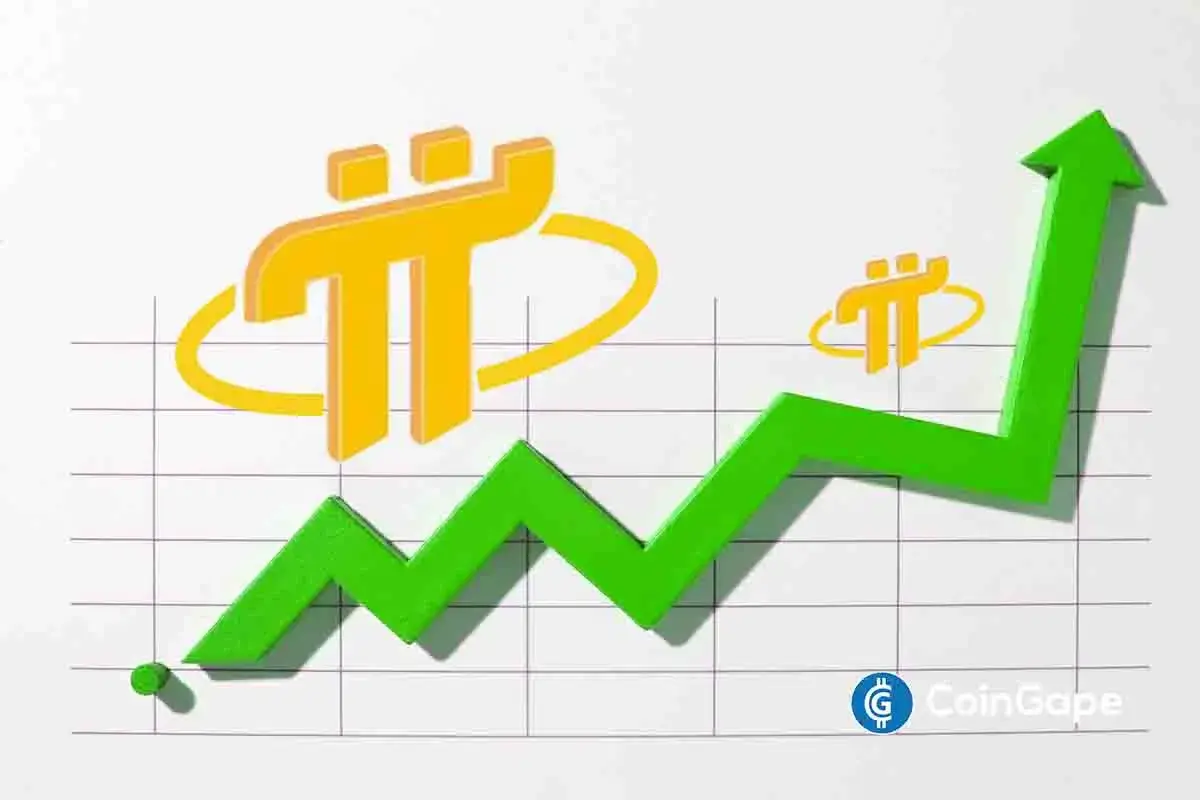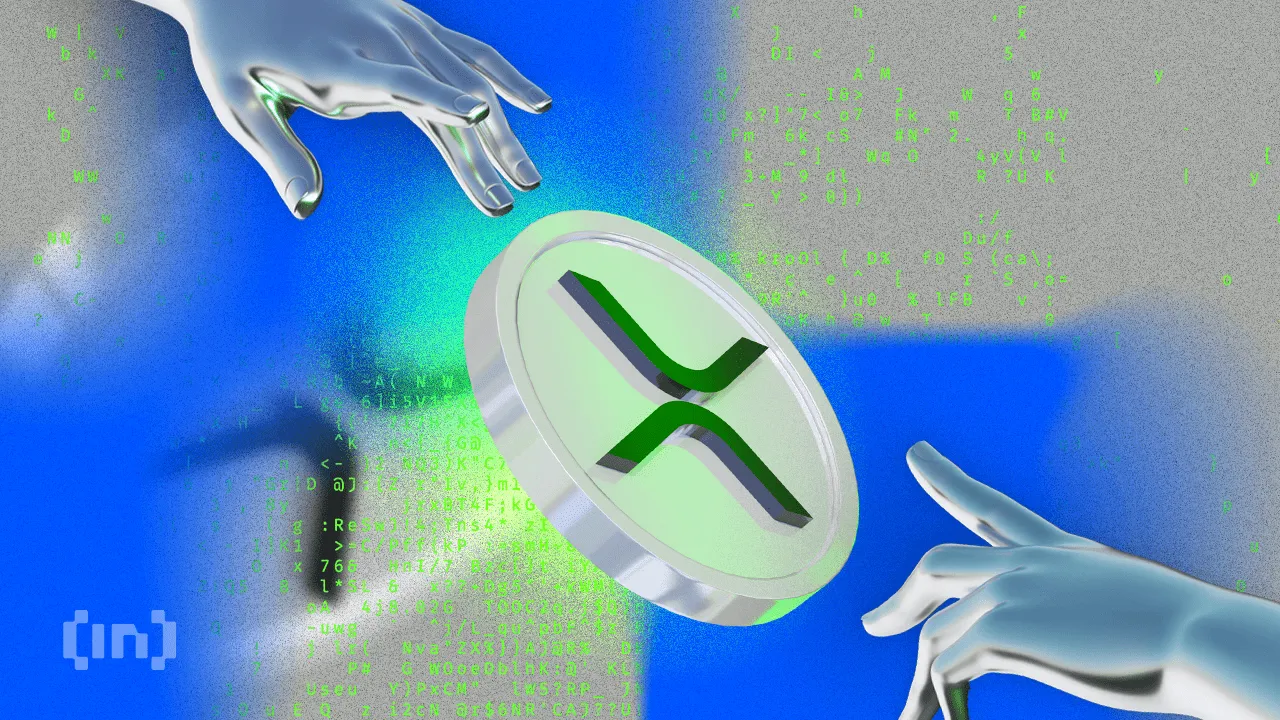Market
Iggy Azalea’s Mother Coin Scandal: $2 Million Insider Trading

Following Caitlyn Jenner’s controversial meme coin launch, Sahil Arora, the “middleman” accused of scamming Jenner and rapper Rich the Kid, has targeted Australian rapper Iggy Azalea.
Arora suggested his next celebrity collaboration for launching a meme coin would be with Azalea, utilizing Solana’s meme coin launchpad, pump.fun.
Inside Iggy Azalea’s Meme Coin Controversy
In his Telegram group, he shared an address and encouraged members to send Solana (SOL) to participate in a presale for a new token named IGGY. He initially opened the presale to 100 wallets but increased the limit to 700 and then to 1,000.
The presale wallet has amassed over $380,000 in cryptocurrency. However, investors claimed that they had yet to receive their tokens.
During its debut, IGGY showed a strong performance. According to data from DEX Screener, it quickly reached a market capitalization of approximately $3 million. Yet, at the time of writing, IGGY is now trading at $0.00003907, with the market capitalization slumped to $39,000.
Read more: Crypto Social Media Scams: How to Stay Safe
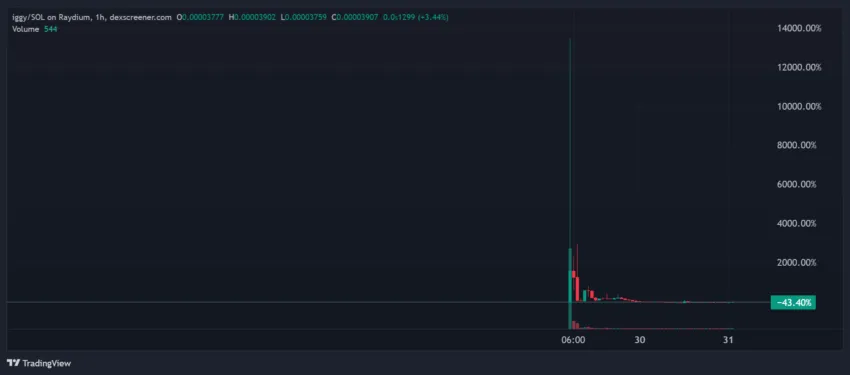
After Arora’s announcement, Azalea declared on her X (Twitter) account that she launched her own meme coin, Mother Iggy (MOTHER), with the token address. She clarified that she independently launched MOTHER, urging her followers not to trust false claims about her involvement with Arora.
“Don’t disappoint your mother. Also don’t believe the bullsh*t, fake screenshots, and all the rest. I know you all are smarter than that. No one is working with me. I can’t say it enough. Not true. Sahil, baby, take your L and go already,” Azalea stated in her post.
Compared to IGGY, MOTHER had a stronger debut. It reached a market capitalization of $18.2 million. DEX Screener data reveals that MOTHER is now trading at $0.008633, with its market capitalization halved to $9.2 million.
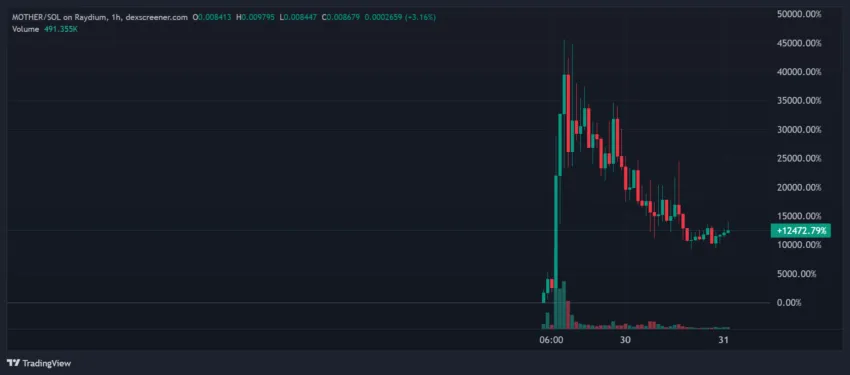
Azalea admitted in an X Space discussion that no one had “really onboarded” her to the crypto industry. She claimed her brother, Mathias ‘Matt’ Kelly, helped her launch the token.
“Matt just likes crypto and honestly, [he] just doesn’t shut up about any type of technology or new thing. Meme coin involves so much more sh*tposting and memeing and stuff that I really like, like that kind of culture of the internet,” she explained.
Furthermore, Azalea outlined her plans to build trust and integrity in the crypto community. She aims to distinguish herself from other controversial celebrity tokens.
“Every time they start rugging, I just want to burn some of mine because I’m a celebrity in the space, and I know I’m going to get hated on for being here. So I’m just going to burn some every time someone comes that’s a celebrity and it’s looking like it’s clearly a rug. I’m just gonna burn,” she affirmed.
Insider Trading Allegations Hit Iggy Azalea’s Meme Coin
Despite Azalea’s efforts, blockchain data provider Bubblemaps discovered “huge insider activity” in the MOTHER meme coin. Insiders bought 20% of the supply at launch before Azalea announced and have since dumped tokens worth $2 million.
According to Bubblemaps, wallet address JEEt3D1dZynWcgEcpPCNP2FvSbydHJiyfurU6QKVDVMH bought 109 trillion MOTHER, equal to 10% of the supply. The wallet then splits those tokens into seven wallets.
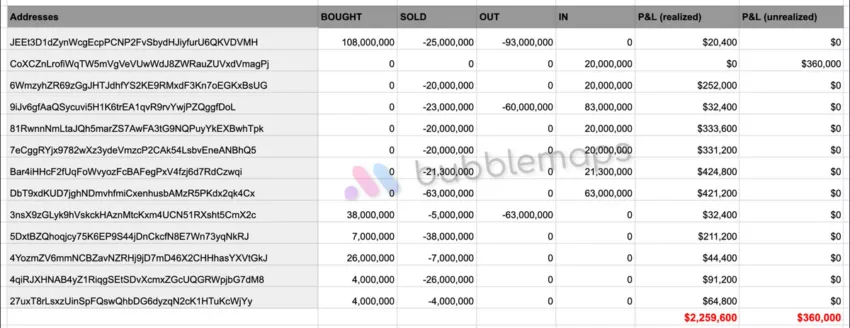
“Out of these, 89 trillion tokens have been sold. Realized profit and loss: $1.4 million. Unrealized profit and loss: $400,000,” Bubblemaps noted.
The wallet sent SOL to highly profitable wallets that made significant returns on MOTHER. These include DbT9xdKUD7jghNDmvhfmiCxenhusbAMzR5PKdx2qk4Cx, 3nsX9zGLyk9hVskckHAznMtcKxm4UCN51RXsht5CmX2c, and 4YozmZV6mmNCBZavNZRHj9jD7mD46X2CHHhasYXVtGkJ. These wallets reportedly made approximately $800,000 by selling 8% of the token supply.
In addition to the discoveries made by Bubblemaps, when on-chain investigator Coffeezilla questioned Arora regarding the recent accusations made by Jenner, Azalea, and Rich the Kid, Arora confessed that the entire situation was “all orchestrated.” He further accused Rich the Kid of exploiting him for publicity by making false allegations of hacking and scams.
“This meta was started by me. They wouldn’t have clocked any of that if I didn’t back them up. Period,” Arora told Coffeezilla in an Instagram message.
Davido’s Meme Coin Exit Raises Eyebrows
In a related development, American-born Nigerian singer Davido launched a meme coin named after himself. On-chain tracker platform Lookonchain reported that Davido created the token on Wednesday using pump.fun. He received 7.5 SOL (approximately $1,275) as initial capital and spent 7 SOL ($1,190) to buy 203 million DAVIDO, equaling 20.3% of the total supply.
Several hours after creating and promoting the meme coin on his social media, Davido cashed out 121.88 million DAVIDO for 2,791 SOL, generating roughly $474,400. This transaction led to speculation that Davido made this token solely for pump and dump.
In response to the trend of celebrity meme coins, Wale Moca, a researcher at Azuki, examined past celebrity-owned and celebrity-promoted crypto projects. According to Moca, they all failed, with most being scams. This pattern raises concerns about the sustainability and integrity of such ventures.
“At the end of the day, these projects usually fail because the individuals behind them just don’t care. Either they get a bag for promoting and posting a video or their team coordinates a sale. In most cases, there is no real interest or plan for the project. […] I would be surprised if any of the celebrities that promoted them even know what’s going on,” Moca explained.
Read more: Crypto Scam Projects: How To Spot Fake Tokens
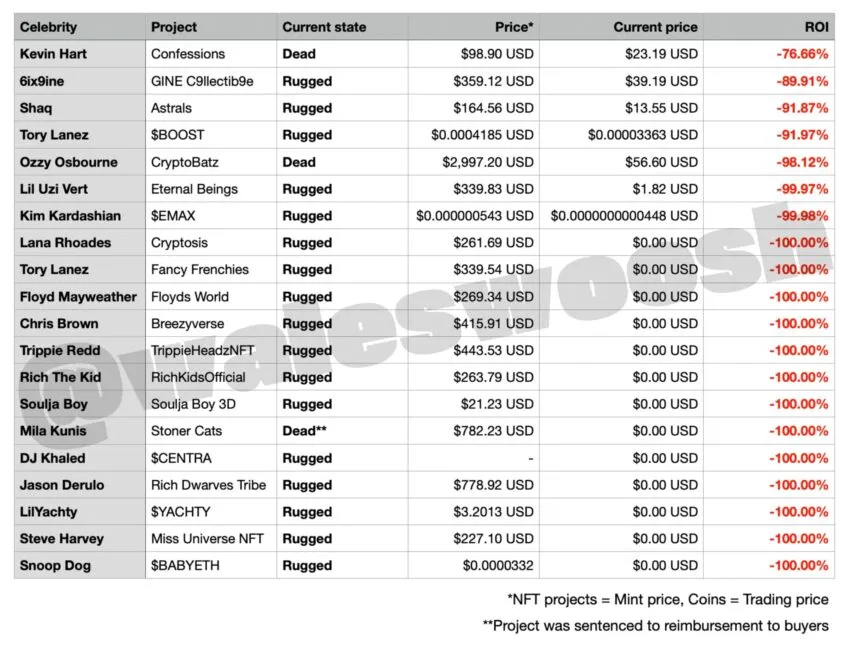
Regulatory bodies have previously taken action against misleading crypto promotions. In October 2022, the US Securities and Exchange Commission (SEC) charged Kim Kardashian for promoting EthereumMAX (EMAX) as crypto asset security without disclosing her financial compensation. Kardashian settled the charges by paying $1.26 million in penalties and cooperating with the ongoing investigation.
Disclaimer
In adherence to the Trust Project guidelines, BeInCrypto is committed to unbiased, transparent reporting. This news article aims to provide accurate, timely information. However, readers are advised to verify facts independently and consult with a professional before making any decisions based on this content. Please note that our Terms and Conditions, Privacy Policy, and Disclaimers have been updated.
Market
XRP Consolidation About To Reach A Bottom, Wave 5 Says $5.85 Is Coming

Reason to trust

Strict editorial policy that focuses on accuracy, relevance, and impartiality
Created by industry experts and meticulously reviewed
The highest standards in reporting and publishing
Strict editorial policy that focuses on accuracy, relevance, and impartiality
Morbi pretium leo et nisl aliquam mollis. Quisque arcu lorem, ultricies quis pellentesque nec, ullamcorper eu odio.
XRP is still in consolidation mode after hitting a new seven-year high in January 2025. This consolidation has seen the price drop slowly, but steadily, losing around 40% of its value since then. Currently, bulls seem to have created support for the altcoin at $2, as this level continues to hold even through crashes. Thus, it has created the expectation that the bottom could be close for the XRP price, and this could serve as a bounce-off point.
XRP Price Consolidation Could Be Over Soon
Taking to X (formerly Twitter), crypto analyst Dark Defender revealed that the consolidation that the XRP Price has been stuck in for months now is coming to an end. The analyst used the monthly chart for the analysis, calling out an end and a bottom for the XRP price. According to him, this is actually the “Final Consolidation” for XRP, suggesting that this is where a breakout would start from.
Related Reading
With the consolidation expected to come to an end soon, the crypto analyst highlights what could be next for the altcoin using the 5-Wave analysis. Now, in total, these five waves are still very bullish for the price and could end up marking a new all-time high.
For the first wave, Dark Defender calls it the Impulsive Wave 1, which is expected to begin the uptrend. This first wave is expected to push the price back to $3 before the second wave starts, and this second wave is bearish.
The second wave would trigger a crash from $3 back toward $2.2, providing the setup for the third wave. Once the third wave begins, this is where the crypto analyst expects the XRP price to hit a new all-time high. The target for Wave 3 puts the XRP price as high as $5, clearing the 2017 all-time high of $3.8.
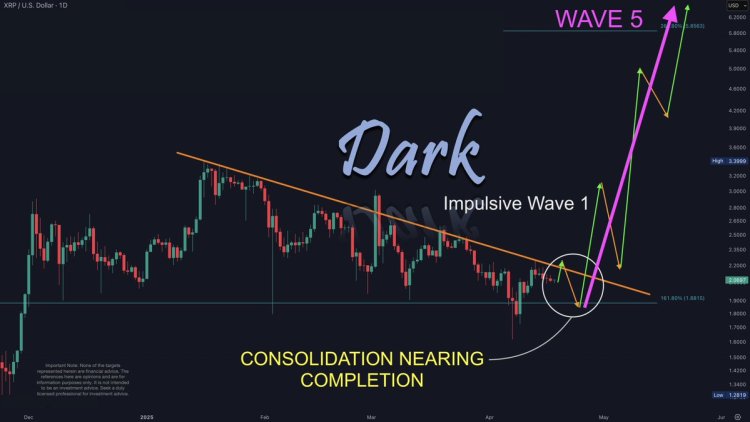
Next in line is the fourth wave, which is another bearish wave. This wave will cause at least a 30% crash, according to the chart shared by the crypto analyst, taking it back toward the $3 territory once again. However, just like the second bearish wave, the fourth bearish wave is expected to set up the price for a final and more explosive Wave 5.
Related Reading
Once the fifth wave is in action, a brand-new all-time high is expected to happen, with the price rising over 100% from the bottom of the fourth wave. The target for this, as shown in the chart, is over $6.
As for the crypto analyst, the major targets highlighted during this wave action are $3.75 and $58.85. Then, for major supports and resistances, supports are $1.88 and $1.63, while resistances lie at $2.22 and $2.30.
Featured image from Dall.E, chart from TradingView.com
Market
Despite an 18% Drop, XRP’s Exchange Supply Hits Lows—Bullish Setup Ahead?

Reason to trust

Strict editorial policy that focuses on accuracy, relevance, and impartiality
Created by industry experts and meticulously reviewed
The highest standards in reporting and publishing
Strict editorial policy that focuses on accuracy, relevance, and impartiality
Morbi pretium leo et nisl aliquam mollis. Quisque arcu lorem, ultricies quis pellentesque nec, ullamcorper eu odio.
XRP has been trading under pressure in recent weeks, losing much of the momentum it built during its late 2024 to early 2025 rally. After reaching highs above $3.40, the asset has experienced an 18.3% decline over the past month, reflecting broader market softness.
At the time of writing, XRP trades significantly below its peak at a price of $2.06, with subdued investor activity and falling market participation across both spot and derivatives markets.
Related Reading
XRP On-Chain Activity Slows, But Price Remains Relatively Stable
Amid XRP’s decline, a CryptoQuant analyst known as EgyHash has recently shared his analysis on the altcoin in a post titled, “XRP’s Market Paradox: With Ledger Activity Dipping 80%, Is a Rebound on the Horizon?”
According to EgyHash, XRP’s on-chain and futures market data presents a mixed picture—declining activity but resilience in price. EgyHash noted that XRP Ledger activity has fallen sharply since December, with the percentage of active addresses down by 80%.
Similar declines have been observed in the futures market, where open interest has dropped roughly 70% from its highs, and funding rates have occasionally turned negative.

He added that the Estimated Leverage Ratio, which gauges average user leverage by comparing open interest to coin reserves, has also dropped significantly.
Despite these indicators pointing to weakening momentum, the altcoin’s price has only declined about 35% from its peak. This is a milder correction compared to other assets such as Ethereum, which has fallen roughly 60% over the same period.
Additionally, the altcoin’s Exchange Reserve has continued to decline, reaching levels last observed in July 2023. Lower reserves typically suggest that fewer tokens are available for immediate sale, a factor that can help support prices during market downturns.

According to EgyHash, this trend, along with relatively stable pricing, could indicate growing long-term confidence in the asset.
Institutional Developments Could Strengthen Market Sentiment
While on-chain metrics remain a focus, institutional developments may also play a role in shaping XRP’s future trajectory. Hong Kong-based investment firm HashKey Capital recently announced the launch of the HashKey XRP Tracker Fund—the first XRP-focused investment vehicle in Asia.
Backed by Ripple as the anchor investor, the fund is expected to transition into an exchange-traded fund (ETF) in the future. The initiative is designed to attract more institutional capital into the XRP ecosystem.
HashKey Capital is launching Asia’s first XRP Tracker Fund—with @Ripple as an early investor.
This marks a major step in expanding institutional access to XRP, the third-largest token by market cap. 🧵👇
— HashKey Capital (@HashKey_Capital) April 18, 2025
HashKey Capital has also indicated that this collaboration with Ripple could lead to further projects, including tokenized investment products and decentralized finance (DeFi) solutions.
Related Reading
Vivien Wong, a partner at HashKey, emphasized the strategic value of integrating Ripple’s network with regulated investment infrastructure across Asia.
Although the altcoin faces near-term pressure, long-term developments, including decreasing exchange reserves and rising institutional interest, may support its recovery as the broader market stabilizes.
Featured image created with DALL-E, Chart from TradingView
Market
Matchain’s Petrix Barbosa Talks the Future of Digital Identity


In an engaging session during Paris Blockchain Week, BeInCrypto caught up with Petrix Barbosa, the innovative mind behind Matchain, a blockchain venture that’s reshaping how digital identity and data sovereignty are approached.
Barbosa, who transitioned from a successful career as a venture capitalist, where he managed investments across 250 projects, brings a wealth of experience and a unique perspective to the blockchain landscape. Petrix Barbosa’s insights reveal a compelling vision for the future of blockchain, focusing on user empowerment and innovative use of technology to solve enduring problems in digital identity and data management.
Petrix Barbosa Discusses Matchain and its Mission
Matchain is a layer 2 blockchain platform that primarily addresses the challenges of identity and data sovereignty. Our mission is to empower users by giving them control over their digital identities and data, thus ensuring that they’re the primary beneficiaries of their online presence.
Barbosa on His Pivot from Venture Capital
In my time as an investor, I witnessed many great ideas fail to reach their potential due to the lack of a substantial user base or poor market timing. This inspired me to transition from funding projects to creating a platform that not only serves my vision but also provides tangible solutions to widespread issues in the blockchain community—primarily, user engagement and application.
Matchain’s Innovations in the Area of Identity Sovereignty
Matchain introduces a novel approach to managing digital identity. Unlike traditional models where user data is siloed across various platforms, Matchain allows users to have a single digital identity that spans across both Web2 and Web3. This is crucial for enabling a seamless transition and interaction between these two worlds.
How Matchain Integrates Existing Web2 Infrastructure
Our platform acts as a bridge between the decentralized ecosystem of Web3 and the more traditional Web2 infrastructure. By allowing users to manage their digital identities across both platforms, we facilitate a smoother interaction that enhances user experience while maintaining high security and trust.
Future Developments From Matchain
Looking ahead, we aim to expand our user base significantly. Currently, we are backed by strategic partnerships, like the one with Paris Saint-Germain, which not only broadens our exposure but also integrates our technology into mainstream applications.
In the next two years, we plan to onboard millions of users, leveraging our innovative solutions to enhance their digital interactions.
Barbosa on Unique Challenges in Developing Matchain
The biggest challenge was shifting the focus from simply creating a blockchain solution to ensuring it was user-centric and capable of addressing real-world problems. This involved integrating AI to manage and analyze data effectively, ensuring that our platform could deliver personalized and contextually relevant experiences to users.
Matchain Over the Next Five Years
In five years, I envision Matchain at the forefront of blockchain technology, leading the charge in digital identity management and data sovereignty. Our platform will likely become a critical tool for users and companies looking to navigate the complexities of the digital age securely and efficiently.
Disclaimer
In compliance with the Trust Project guidelines, this opinion article presents the author’s perspective and may not necessarily reflect the views of BeInCrypto. BeInCrypto remains committed to transparent reporting and upholding the highest standards of journalism. Readers are advised to verify information independently and consult with a professional before making decisions based on this content. Please note that our Terms and Conditions, Privacy Policy, and Disclaimers have been updated.
-

 Market24 hours ago
Market24 hours agoVietnam Partners with Bybit to Launch Legal Crypto Exchange
-
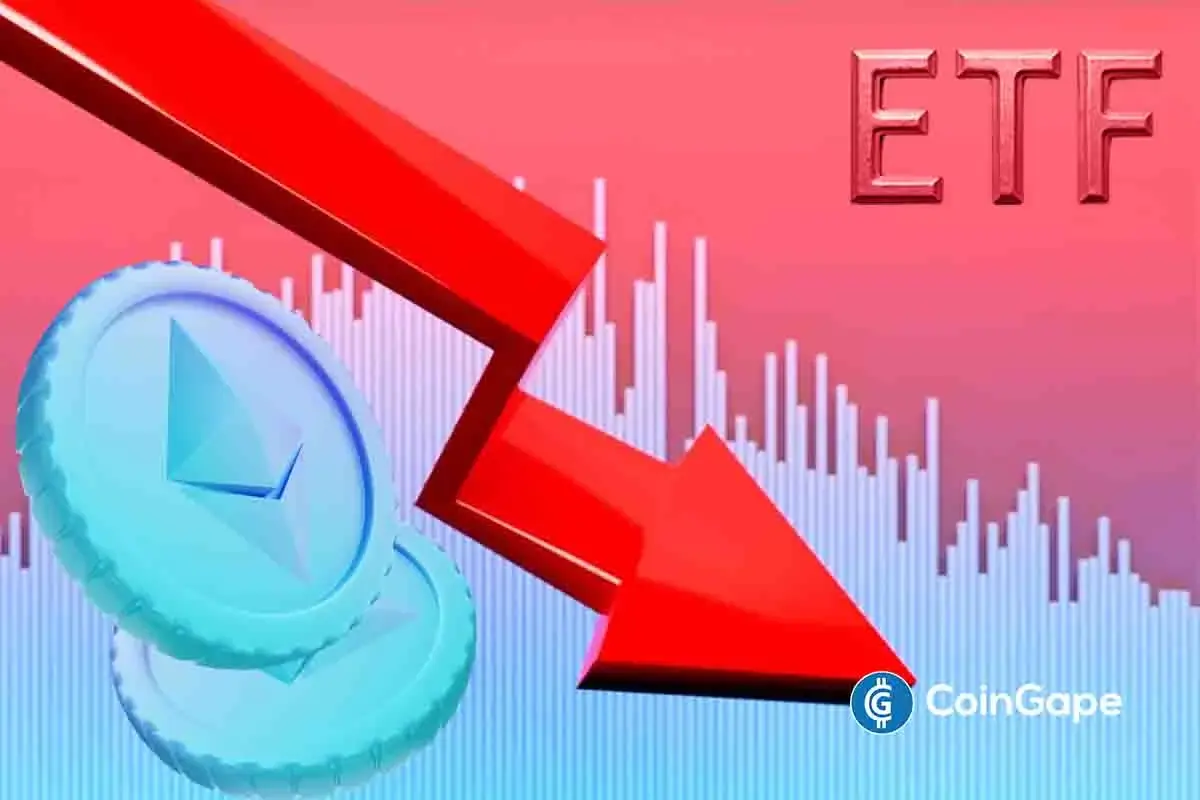
 Altcoin19 hours ago
Altcoin19 hours agoEthereum ETFs Record $32M Weekly Outflow; ETH Price Crash To $1.1K Imminent?
-

 Market11 hours ago
Market11 hours agoPi Network Roadmap Frustrates Users Over Missing Timeline
-

 Market10 hours ago
Market10 hours agoSolana (SOL) Price Rises 13% But Fails to Break $136 Resistance
-

 Market23 hours ago
Market23 hours ago100 Million Tokens Could Trigger Decline
-

 Market15 hours ago
Market15 hours agoBANK Token Surges 150% After Binance Futures Listing
-

 Altcoin15 hours ago
Altcoin15 hours agoXRP Price History Signals July As The Next Bullish Month
-

 Market21 hours ago
Market21 hours agoWhy Relying on TVL Could Mislead Your DeFi Strategy






